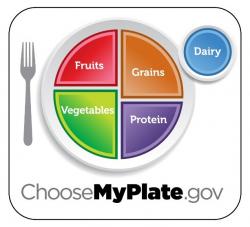
A healthy diet is key in providing your body the energy it needs to function efficiently. The following information is from the Dietary Guidelines for Americans and MyPlate. For more detailed information, professional staff are available for drop-in sessions and educational workshops.
MyPlate illustrates the five food groups that serve as the building blocks for a healthy diet:
-
Make half of your plate fruits and vegetables.
-
Vary your vegetable intake and include nutrient-dense vegetables.
-
Make at least half your fruit intake whole fruits and the rest 100% juice without added sugars.
-
Make at least half your total grain intake nutrient-dense, whole grains, such as 100% whole wheat bread and brown rice.
-
Include fat-free and low-fat, low-lactose and lactose-free, or fortified soy dairy products.
-
Choose foods that provide more potassium, dietary fiber, calcium, and vitamin D, which are nutrients of concern in American diets.
-
Aim to keep your intake of added sugars and saturated fat to under 10% of calories per day and your sodium intake to less than 2,300 milligrams per day.
-
Alcohol increases your overall risk of death from various causes. Individuals who choose to drink are encouraged to limit their intake of alcoholic beverages to two or less in a day for men, or one drink or less for women.
-
Replace processed or high-fat meats with seafood, beans, peas, or lentils.
-
Learn how to read a food label.
-
Read this infographic to learn how to make every bite count.
-
Customize your diet with the Dietary Guidelines framework.
-
Reducing portion size is encouraged to help you make choices that will better fit within your calorie needs.
-
Prepare meals at home to have more control over the types of food ingredients in your meal.
-
Try a variety of options from each food group.
-
Establish an ongoing pattern of healthy eating habits.
-
Satisfy your sweet tooth in a healthy way:
-
Try creating a fruit parfait with Greek yogurt and fresh fruit layers. Add unsalted nuts/seeds/whole grain cereal for a crunch.
-
Cut ½-inch banana slices, dip in melted chocolate, and freeze.
-
Frozen grapes.
-
Substitute frozen sorbet or frozen yogurt for a scoop of ice cream.
-
Make a fruit smoothie with fresh fruit, 100% fruit juice, low-fat milk, and ice.
-
Chocolate milk is a great way to fit in a hint of sweetness. It’s also an effective post-workout recovery drink, too.
-
Nutrient-dense foods and beverages provide vitamins, minerals, and other health-promoting components and have little added sugars, saturated fat, and sodium. Vegetables, fruits, whole grains, seafood, eggs, beans, peas, and lentils, unsalted nuts and seeds, fat-free and low-fat dairy products, and lean meats and poultry – when prepared with no or little added sugars, saturated fat, and sodium – are nutrient-dense foods.
Vegetarian Diets:
Gluten-Free Diet for Celiac Disease
Diabetic Diets
Cholesterol & Blood Pressure
-
Visit the Young Adults website for healthy eating tips, cooking basics, and more resources.
Updated: April 16, 2024